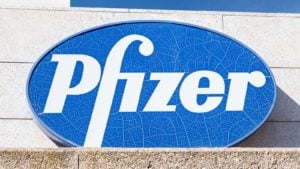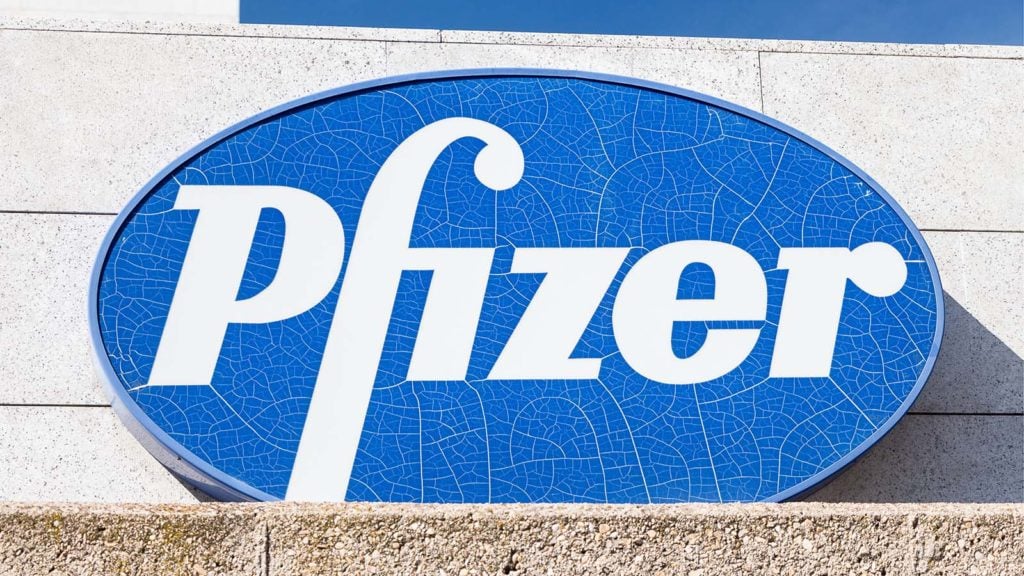In 2020, many drug stocks have behaved like pot stocks did in 2018. Investors have paid huge premiums on sales for even the promise of a novel coronavirus treatment or vaccine. But if you’re looking for value, consider Pfizer (NYSE:PFE). You can still buy PFE stock at a reasonable price.

Pfizer was trading at $37/share early on Oct. 8. That’s a market cap of $203 billion, based on 2019 sales of $51.75 billion. But the price-to-earnings ratio is just 14.5 and the 38 cent per share dividend still yields 4.1%, at a time when the 30-year government bond trades at 1.5%.
How is this possible? Blame a long history of underperformance, the efforts to improve that performance, and a preference for more speculative issues.
Pfizer’s Covid-19 Play
Pfizer is the senior partner in a Covid-19 vaccine effort built on technology from BioNTech (NASDAQ:BNTX) of Germany. Investors seeking a profit on that play have been piling into BioNTech, which had 2019 sales of $109 million but entered trade Oct. 8 at $88/share, a market cap of $21 billion. Analysts say the combination, along with Moderna (NASDAQ:MRNA), are leading the race. While the market will be worth billions, the price is likely to be controlled by governments.
Pfizer is the manufacturing partner, with what CEO Albert Bourla, a veterinarian by training, calls an “open checkbook.” Even before Phase 3 trials are done, the company has produced hundreds of thousands of doses of the BioNTech vaccine.
Bourla says his company is “moving at the speed of science.” He has acted as a public face for the effort, seeking to assure consumers the result will be something safe and effective. He is caught between a president who wants to rush emergency use authorizations and a public that’s increasingly skeptical of all vaccines.
In addition to the vaccine, Pfizer has begun Phase 1 studies of a treatment for Covid-19, an antiviral that will combine with Remdesivir from Gilead Sciences (NASDAQ:GILD), which Trump has been taking. Pfizer says the combination has proven potent in pre-human studies.
Beyond the Coronavirus
What makes Pfizer interesting lies beyond COVID, including work on other vaccines, on immunology, and on rare diseases.
The company also has cash. It had $22.7 billion of cash on its balance sheet at the end of June. It recently paid $200 million for a 9.9% stake in a Chinese cancer drug company, CStone.
Pfizer’s best-known vaccine is Prevnar, for pneumonia, which had sales of $5.85 billion last year. The company recently told analysts it has three more vaccines in development, whose sales could equal that figure by the end of the decade.
Pfizer’s best-known drug right now is Xeljanz, an immunosuppressant (called a JAK inhibitor) for which it now has four indications, including arthritis. Xeljanz has the second-largest ad budget in the industry, recording sales of $2.24 billion last year.
The Bottom Line on PFE Stock
Since becoming CEO, Bourla has sought to pull Pfizer away from its “patent cliff.” Drugs like Viagra and Lipitor have lost patent protection, and are being spun out along with UpJohn from Mylan (NYSE:MYL) into a new company called Viatris.
The pandemic forced a delay in that spinoff, so if you’re an income investor you can still get in by buying Pfizer.
Selling off aging profit centers, however, puts the main company dividend, which costs $2.1 billion per quarter, into jeopardy. Thus, the stock hasn’t moved much.
Pfizer’s current guidance is that 2020 free cash flow will come to $10 billion to $11 billion, cutting the dividend and indicating a yield of 3.6%. But board members like former FDA Commissioner Scott Gottlieb and investment banker Ronald Blaylock have been buying Pfizer lately.
You might want to join them.
On the date of publication, Dana Blankenhorn did not have (either directly or indirectly) any positions in any of the securities mentioned in this article.
Dana Blankenhorn has been a financial and technology journalist since 1978. He is the author of the environmental thriller Bridget O’Flynn and the Bear, available at the Amazon Kindle store. Write him at danablankenhorn@gmail.com or follow him on Twitter at @danablankenhorn.
